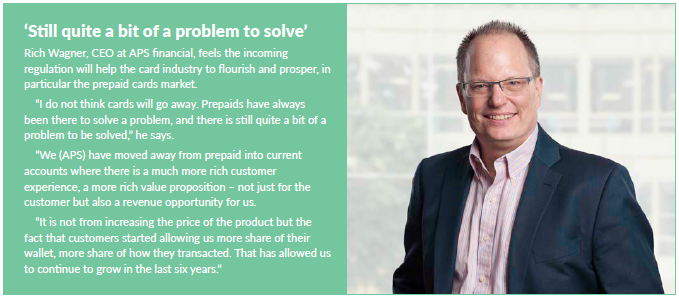
The combination of PSD2 and SEPA Instant Credit Transfer (SCT Inst), which actually comes into play during the final quarter of 2017, is a recipe which could cut out a great portion of the card payment industry.
According to the European Commission, PSD2’s main aims are to:
- Contribute to a more integrated and efficient European payments market
- Level the playing field for payment service providers (including new players)
- Make payments safer and more secure
- Protect consumers
- Encourage lower prices for payments
The European Commission is trying to achieve a market where there is innovation, where there is a combination of factors which will help the consumer and small businesses.
CARDS WON’T LOSE OUT
So, who are the main voices in the Cards Won’t Lose Out camp?
According to Pierre-Antoine Vacheron, CEO at Ingenico ePayments – a company that, it must be pointed out, has put massive investment into payments innovation and application programming interfaces (APIs) – the upcoming changes present no threat to the card payment industry.
“The death of cards is not on the cards amid PSD2 and Instant Payments,” Vacheron asserts confidently.
“Cards have such a strong value and are such an established payment method. Card payments make it simple for the merchant to accept payment from someone they do not know.
“The schemes are so well organised, no one is at risk at all. The card experience is almost perfect, almost transparent – for example Uber – painless payments,” Vacheron adds.
Vacheron also points out that the biggest priority for merchants is to increase conversions.
“There is a shift in the behaviour of merchants, which has been interesting in the last nine months.
“Merchants are feeling the pressure of Amazon – there is a changing paradigm. The only way for them to survive in the shadow of Amazon is to have an omni-channel solution, combining in-store presence with online presence,” he says.
Vacheron goes on to extol the virtues of regulation for creating “massive opportunity” for innovation.
Managing flows within marketplaces, an area for which Ingenico has been busy developing solutions, has been made possible because regulation has enabled banks to manage flows.
“In B2C retail payments, card payments are good; you get the certainty of funds, not debited immediately. Instant payments are a good fit for some use cases, but not all,” Vacheron stresses.
Sarah Francis, consultant at Polymath Consulting, is also sceptical as to the potential dent to card payments posed by PSD2 and Instant Payments. “Overall the concept that this will herald a decline in card payments is, I would say, simplistic,” she notes.
“The operational concepts of replacing cards with multiple bank relationships for all but the very largest retailers would seem challenging, and unlikely.
“It also assumes that all payments are domestic or EU-based, which may represent the majority for some, but it is unlikely to be 100%,” Francis explains.
“Will we see an evolution of payments for the schemes and others? Yes. Will this cause a sharp decline in the business done by Visa and Mastercard? Unlikely. How comfortable would you be handing over your bank details to a shop assistant at your local shop or cafe or restaurant?”
Francis believes the successful regulation, global reach and universal standards and rules of card schemes will not be easy to replicate. Of these, perhaps it is the global acceptance that may pose the biggest challenge: An Instant Payment global standard cannot be implemented overnight.
However, Tom Hay, head of payments at Icon Solutions, argues: “PSD2 and Instant Payments together offer a better and safer customer experience than cards for online shopping.
“The whole idea of a ‘plastic card’ is irrelevant in the digital world.”

CARDS WILL LOSE OUT
Ingenico’s Vacheron used Uber as an example of an “almost perfect – almost transparent” painless card payment.
In stark contrast to Vacheron, Jerry Norton, head of financial services strategy at CGI, uses Uber in a counter-argument. He believes that under PSD2, Uber could become a Third-Party Payments Initiation Service Provider (PISP), which means it could initiate payments to itself.
Whether Uber would want to is a separate argument altogether, however.
Into this argument plays the updated General Data Protection Regulation (GDPR), which ascribes greater control to the consumer, translating into technical and security headaches for all those providing payment services.
The right to be forgotten is no easy feat to prove, digitally speaking, nor are ad hoc amendments to what data is stored or accessible, which will be subject purely to the consumer’s whim.
This may prove to be too much for a smaller player, to the extent that it may decide it not worth the hassle to go down the road of becoming a PISP.
RESEARCH
Ovum consulting, in conjunction with Icon Solutions, put out some research recently, revealing what it hails as “the only quantitative insights” into how PSD2 will act as a catalyst for the decline in card transactions.
It makes sense, particularly in the online domain. It argues that the lower cost and increased convenience offered by Instant Payments will encourage retailers to accommodate these new payments.
It also argues that the merchant demand for these payment services and what it predicts as the decline in card payments will push banks to respond and implement this infrastructure.
It goes further to say that the banks stand to win from the overall shift, as long as they set themselves up in advance of the smaller market players. Presumably the banks would implement Icon’s Instant Payment infrastructure.
![]()
Nevertheless, it is not solely Ovum and Icon Solutions that are raising and answering this question: Norton holds a similar view. When asked whether any party stands to lose under PSD2, “cards” came the immediate answer.
“The threat is because it is coupled with SCT Inst. And banks that do not consciously make a decision about what to do are under threat as well. The proverbial loser is anybody who does not think about the strategic consequences of it,” Norton explains.
“There are three elements to PSD2. There is a funds-check element, a payment-initiation element, and the aggregation element of transactions from multiple providers.
“With SCT Inst there is the opportunity for a retailer to do a funds check at the till and – with the permission of the customer – rather than taking a card payment, access the customer account and take the money there and then, bypassing the card altogether.
“This is great for the retailer because the merchant service charge is removed altogether,” Norton notes.
The jury is out on this one but it is by no means inevitable that cards are going to be killed off any time soon. Chances are the PSD2 deadline will arrive in a pomp of confusion from all parties and nothing much will change – for a while anyway.







